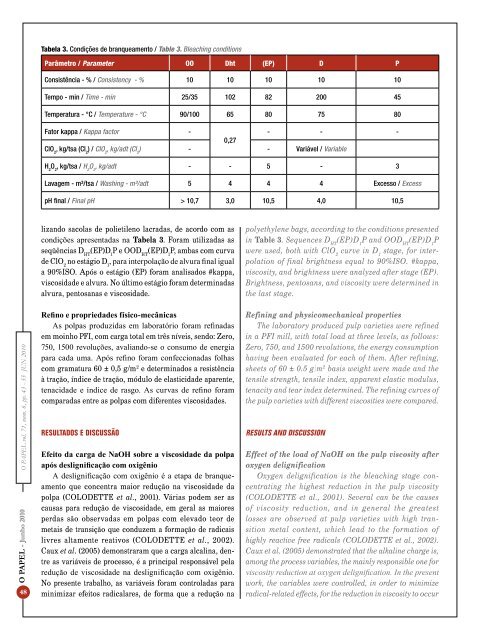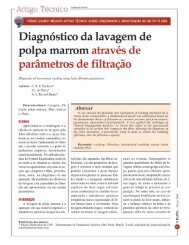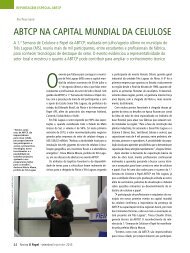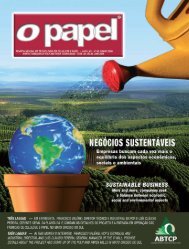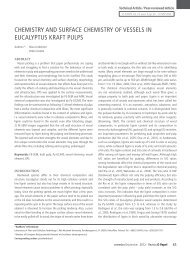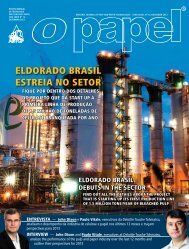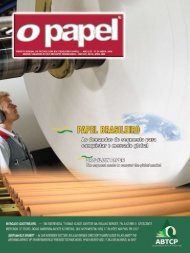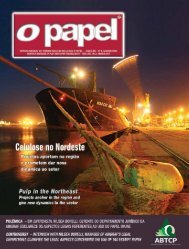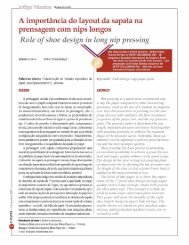Brasil na PulPaper - Revista O Papel
Brasil na PulPaper - Revista O Papel
Brasil na PulPaper - Revista O Papel
Create successful ePaper yourself
Turn your PDF publications into a flip-book with our unique Google optimized e-Paper software.
Tabela 3. Condições de branqueamento / Table 3. Bleaching conditionsParâmetro / Parameter OO Dht (EP) D PConsistência - % / Consistency - % 10 10 10 10 10Tempo - min / Time - min 25/35 102 82 200 45Temperatura - °C / Temperature - °C 90/100 65 80 75 80Fator kappa / Kappa factor -- - -0,27ClO 2, kg/tsa (Cl 2) / ClO 2, kg/adt (Cl 2) - - Variável / VariableH 2O 2, kg/tsa / H 2O 2, kg/adt - - 5 - 3Lavagem - m³/tsa / Washing - m³/adt 5 4 4 4 Excesso / ExcesspH fi<strong>na</strong>l / Fi<strong>na</strong>l pH > 10,7 3,0 10,5 4,0 10,5lizando sacolas de polietileno lacradas, de acordo com ascondições apresentadas <strong>na</strong> Tabela 3. Foram utilizadas asseqüências D HT(EP)D 1P e OOD HT(EP)D 1P, ambas com curvade ClO 2no estágio D 1, para interpolação de alvura fi<strong>na</strong>l iguala 90%ISO. Após o estágio (EP) foram a<strong>na</strong>lisados #kappa,viscosidade e alvura. No último estágio foram determi<strong>na</strong>dasalvura, pentosa<strong>na</strong>s e viscosidade.polyethylene bags, according to the conditions presentedin Table 3. Sequences D HT(EP)D 1P and OOD HT(EP)D 1Pwere used, both with ClO 2curve in D 1stage, for interpolationof fi<strong>na</strong>l brightness equal to 90%ISO. #kappa,viscosity, and brightness were a<strong>na</strong>lyzed after stage (EP).Brightness, pentosans, and viscosity were determined inthe last stage.O PAPEL vol. 71, num. 6, pp. 43 - 55 JUN 2010O PAPEL - Junho 201048Refino e propriedades físico-mecânicasAs polpas produzidas em laboratório foram refi<strong>na</strong>dasem moinho PFI, com carga total em três níveis, sendo: Zero,750, 1500 revoluções, avaliando-se o consumo de energiapara cada uma. Após refino foram confeccio<strong>na</strong>das folhascom gramatura 60 ± 0,5 g/m 2 e determi<strong>na</strong>dos a resistênciaà tração, índice de tração, módulo de elasticidade aparente,te<strong>na</strong>cidade e índice de rasgo. As curvas de refino foramcomparadas entre as polpas com diferentes viscosidades.RESULTADOS E DISCUSSÃOEfeito da carga de NaOH sobre a viscosidade da polpaapós deslignificação com oxigênioA deslignificação com oxigênio é a etapa de branqueamentoque concentra maior redução <strong>na</strong> viscosidade dapolpa (COLODETTE et al., 2001). Várias podem ser ascausas para redução de viscosidade, em geral as maioresperdas são observadas em polpas com elevado teor demetais de transição que conduzem a formação de radicaislivres altamente reativos (COLODETTE et al., 2002).Caux et al. (2005) demonstraram que a carga alcali<strong>na</strong>, dentreas variáveis de processo, é a principal responsável pelaredução de viscosidade <strong>na</strong> deslignificação com oxigênio.No presente trabalho, as variáveis foram controladas paraminimizar efeitos radicalares, de forma que a redução <strong>na</strong>Refining and physicomechanical propertiesThe laboratory produced pulp varieties were refinedin a PFI mill, with total load at three levels, as follows:Zero, 750, and 1500 revolutions, the energy consumptionhaving been evaluated for each of them. After refining,sheets of 60 ± 0.5 g/m 2 basis weight were made and thetensile strength, tensile index, apparent elastic modulus,te<strong>na</strong>city and tear index determined. The refining curves ofthe pulp varieties with different viscosities were compared.RESULTS AND DISCUSSIONEffect of the load of NaOH on the pulp viscosity afteroxygen delignificationOxygen delignification is the bleaching stage concentratingthe highest reduction in the pulp viscosity(COLODETTE et al., 2001). Several can be the causesof viscosity reduction, and in general the greatestlosses are observed at pulp varieties with high transitionmetal content, which lead to the formation ofhighly reactive free radicals (COLODETTE et al., 2002).Caux et al. (2005) demonstrated that the alkaline charge is,among the process variables, the mainly responsible one forviscosity reduction at oxygen delignification. In the presentwork, the variables were controlled, in order to minimizeradical-related effects, for the reduction in viscosity to occur


